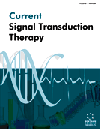- Home
- A-Z Publications
- Current Signal Transduction Therapy
- Previous Issues
- Volume 9, Issue 1, 2014
Current Signal Transduction Therapy - Volume 9, Issue 1, 2014
Volume 9, Issue 1, 2014
-
-
Bortezomib and Arsenious Acid Synergistically Inhibit HL-60 Cells Viability in vitro and in vivo
More LessAuthors: Yunbi Fu, Li li, Qixin Sun and Fanyi MengAims: We investigated whether bortezomib synergizes with arsenious acid in killing promyelocytic leukemia HL-60 cells in vitro and in vivo. Main Methods: Cell culture, MTT assay, Hoechest 33324 staining, flow cytometry assay, determination of DNA fragmentation, immunoblotting analysis, HL60 xenograft mice models and animal experiments. Key Findings: Bortezomib inhibited proliferation of HL-60 cells in a time- and dose Read More
-
-
-
miR-629-3p Level Significantly Predicts Prognosis in Glioblastoma Patients Treated with Temozolomide Chemotherapy
More LessAuthors: Chen Hui-Yuan, Li Wen-Bin, Zhang Chuan-Bao, Zhang Wei and Zheng Hu-YongBackground: Glioblastoma is the most aggressive and common primary tumor of the central nervous system. Resistance to temozolomide, the first-line chemotherapy for glioblastoma, always leads to treatment failure. Further understanding of the molecular mechanisms of temozolomide resistance in glioblastoma is desperately needed. The purpose of this study was to identify miRNAs correlated with temozolomide treat Read More
-
-
-
Fibroblast Growth Factor Receptor Signaling in Cancer Biology and Treatment
More LessAuthors: Melanie Heroult, Peter Ellinghaus, Stuart Ince and Matthias OckerGrowth factor signaling via receptor tyrosine kinases plays a central role in initiating and maintaining a malignant phenotype. Fibroblast growth factors (FGF) and their receptor family (FGFR1-4) are key players in various human solid and hematological tumors and have been linked to tumor cell proliferation, resistance to chemotherapy and apoptosis, angiogenesis, invasion and metastasis. FGFRs are commonly activated by Read More
-
-
-
Chinese Medicine: A Novel Therapeutic Option for Pancreatic Cancer
More LessAuthors: Ping Yan, Yongxing Cao and Xiaotian SunPancreatic cancer is one of the most common human cancers with very low survival rate. So far, the difficulties to make early diagnosis and find curative therapy for this malignant disease remain challenging. Considering Chinese medicine with a long history of clinical application in treating various human diseases, it has been now introduced into the anti-cancer treatment and begun to attract attentions of researchers world Read More
-
-
-
Perspective of MiRNAs in Clinical Glioblastoma Research
More LessAuthors: Chunming Xiu, Wenwen Qi, Yunbo Wang, Hongtao Zhang and Nan ChiPioneer works have identified some microRNAs (miRNAs) with oncogenic or tumor-suppressive properties in glioblastoma multiforme (GBM), an aggressive brain tumor with dismal prognosis. Differential expression of these noncoding small RNA in cancers positions them as attractive biomarkers for diagnosis, prognosis and therapeutic decision in GBMs. In addition, abnormal miRNAs provide new interesting therapeutic Read More
-
-
-
A Hypothesis for Regenerative Therapy for Neuronal Disease: Stem Cells within Artificial Niche
More LessAuthors: Jialin Liu, Zhiwen Zhang, Jinghui Xue, Haitao Zhang, Yuxiao Liu and Fengyun HuStem cells, which maintain self-renewal behavior and produce multiple mature cells, are recognized to be the best cell source for transplantation in regenerative medicine. Recently, stem-cell based transplantation has become an important pre-clinical attempt for neuronal injury and degeneration diseases, such as spinal cord injury, amyotrophic lateral sclerosis, and Alzheimer disease. However, the poor survival rate Read More
-
-
-
Analysis of Clinicopathological Characteristics and Prognosis of 1425 Primary Breast Cancer Patients in Eastern Guangdong, China
More LessAuthors: Wen-He Huang, Si-Qi Qiu, Jun-Dong Wu, Cai-Wen Du, Yu-Kun Cui and Guo-Jun ZhangWe analyzed the clinicopathological characteristics of 1,425 primary breast cancer patients admitted to the Cancer Hospital of Shantou University Medical College from 1995 to 2008. The peak age group was 45-49 years old and median age was 49 years old. Sixty-two percent of the patients were pre-menopausal, while the remaining was postmenopausal. In the present study, 53% of the patients were in stage I-II of TNM stag Read More
-
-
-
7-Difluoromethyl-5, 4’-Dimethoxygenistein Reverses LPC-Induced Apoptosis of HUVE-12 Cells Through Regulating Mitochondrial Apoptosis Pathway
More LessAuthors: Shiwei Liu, Lesai Li, Jing Zhang, He Huang, Shuting Yang, Changjie Ren, Xiaohua Fu and Yong Zhang7-Difluoromethyl-5, 4’-dimethoxygenistein (DFMG), prepared by the difluoromethylation and alkylation of Genistein, is a new active chemical entity. In this study, we investigated the inhibitory effect of DFMG on Lysophosphatidyl choline (LPC)-induced apoptosis of human umbilical vein endothelial cells-12 (HUVEC-12) through mitochondrial apoptosis pathway. Lysophosphatidyl choline (LPC) was used to build apoptosis model in HUV Read More
-
Volumes & issues
-
Volume 20 (2025)
-
Volume 19 (2024)
-
Volume 18 (2023)
-
Volume 17 (2022)
-
Volume 16 (2021)
-
Volume 15 (2020)
-
Volume 14 (2019)
-
Volume 13 (2018)
-
Volume 12 (2017)
-
Volume 11 (2016)
-
Volume 10 (2015)
-
Volume 9 (2014)
-
Volume 8 (2013)
-
Volume 7 (2012)
-
Volume 6 (2011)
-
Volume 5 (2010)
-
Volume 4 (2009)
-
Volume 3 (2008)
-
Volume 2 (2007)
-
Volume 1 (2006)
Most Read This Month
Article
content/journals/cst
Journal
10
5
false
en


